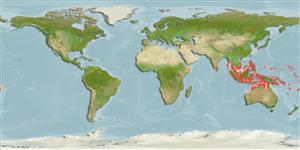Common names from other countries
>
Clupeiformes (Herrings) >
Dorosomatidae (Gizzard shads and sardinellas)
Etymology: Amblygaster: Greek, amblys = darkness + Greek, gaster = stomach (Ref. 45335).
Eponymy: Dr Pieter Bleeker (1819–1878) was an ichthyologist and army surgeon commissioned (1841) by the Dutch East India Company. [...] (Ref. 128868), visit book page.
More on author: Bleeker.
Environment: milieu / climate zone / rango de profundidad / distribution range
Ecología
marino asociado a arrecife; rango de profundidad 0 - 50 m (Ref. 188). Tropical; 17°N - 19°S, 75°E - 179°W (Ref. 188)
Indo-West Pacific: southern coasts of India, perhaps Bay of Bengal, and Indonesia eastward to Fiji. Reported from New Caledonia (Ref. 9070) and Tonga (Ref. 53797).
Tamaño / Peso / Age
Madurez: Lm ? range ? - ? cm
Max length : 27.6 cm TL macho / no sexado; (Ref. 126292); common length : 15.0 cm SL macho / no sexado; (Ref. 188); peso máximo publicado: 247.00 g (Ref. 126292)
Espinas dorsales (total) : 0; Radios blandos dorsales (total) : 13 - 21; Espinas anales: 0; Radios blandos anales: 12 - 23. Body moderately deep, belly rather rounded, scutes not prominent. Distinguished from A. sirm by the absence of spots along the flank (gold in life, black on preservation) and fewer lower gill rakers. Closely resembles A. leiogaster, which has more lower gill rakers. Round-bodied Sardinella species have i 8 pelvic fin rays and more than 100 lower gill rakers.
Body shape (shape guide): fusiform / normal; Cross section: compressed.
Forms schools in coastal waters. Feeds on copepods, Mysis and other elements in the zooplankton. Used as bait in the tuna fishery.
Life cycle and mating behavior
Madurez | Reproducción | Puesta | Huevos | Fecundidad | Larva
Spawn in school (Ref. 205).
Whitehead, P.J.P., 1985. FAO Species Catalogue. Vol. 7. Clupeoid fishes of the world (suborder Clupeoidei). An annotated and illustrated catalogue of the herrings, sardines, pilchards, sprats, shads, anchovies and wolf-herrings. FAO Fish. Synop. 125(7/1):1-303. Rome: FAO. (Ref. 188)
IUCN Red List Status (Ref. 130435: Version 2025-1)
Threat to humans
Harmless
Human uses
Pesquerías: comercial; carnada: usually
Herramientas
Special reports
Download XML
Fuentes de Internet
Estimates based on models
Preferred temperature (Referencia
123201): 27.2 - 29.1, mean 28.5 °C (based on 988 cells).
Phylogenetic diversity index (Referencia
82804): PD
50 = 0.5625 [Uniqueness, from 0.5 = low to 2.0 = high].
Bayesian length-weight: a=0.00813 (0.00458 - 0.01442), b=3.07 (2.92 - 3.22), in cm total length, based on LWR estimates for this species & (Sub)family-body (Ref.
93245).
Nivel trófico (Referencia
69278): 3.1 ±0.28 se; based on food items.
Resiliencia (Referencia
120179): Alto, población duplicada en un tiempo mínimo inferior a 15 meses (Assuming Fec > 10,000).
Fishing Vulnerability (Ref.
59153): Low vulnerability (18 of 100).
🛈
Nutrients (Ref.
124155): Calcium = 95.5 [30.8, 395.3] mg/100g; Iron = 1.53 [0.53, 3.60] mg/100g; Protein = 20.2 [17.5, 22.6] %; Omega3 = 0.259 [0.118, 0.565] g/100g; Selenium = 51.1 [16.6, 168.4] μg/100g; VitaminA = 79.2 [16.6, 367.3] μg/100g; Zinc = 1.42 [0.70, 2.70] mg/100g (wet weight);
